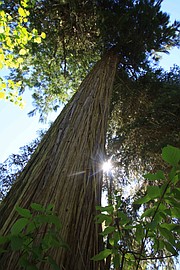A tale of two rivers
By RALPH BARTHOLDT
Staff Writer
Tim Trainor waded across the smooth stone bottom of the St. Joe River Sunday to throw a stonefly pattern against a rock wall where the river rushed fast before fanning in bubbles under the shade of trees.
He edged out farther into the current and after several casts hooked a 14-inch cutthroat trout.
More casting. No more takes.
“What’s changed?” he asked after pushing against the cold mountain water back to shore, where the sun raised the air temperature to near 85 degrees.
A day earlier, Trainor said, cutthroat were taking all manner of flies with relish and the fish were fat and sporty.
The next day, the fishing was good, but the catching not so much.
Downriver in the Avery fly shop, owner Dan Mottern coached his daughter Emily, who was behind the cash register, to let people know fish were taking mayflies, not green drakes — a green-bodied early summer fly compared to the light–colored, often-ubiquitous mayflies — which is what a lot of anglers expected.
“Just tell them mayflies,” he said.
The next day, he changed his mind.
“Green drakes,” he said.
If early summer weather in North Idaho is unpredictable, the fishing on the Panhandle’s rivers can be just as dicey.
So far this spring, the river has flowed pretty close to the normal, about 2,200 cubic feet per second at the measuring site in Calder about 20 miles downstream from Avery,
A few years of drought, though — two years ago at this time the Calder station recorded a flow of around 670 cubic feet per second — have stamped the age-old question mark in the mind of anglers: Wasn’t the river a lot smaller last year, or was it bigger?
There is one certainty: The fish are there.
“Fish density in the St. Joe has traditionally been a little lower,” fishery biologist Carson Watkins of the Idaho Department of Fish and Game said.
Over the past decade however the tables have turned.
“That’s changed,” Watkins said.
Cutthroat trout populations in the St. Joe, about 60 fish per acre, have surpassed those in the Panhandle’s other popular river fishery, the Coeur d’Alene River system, which logs about 40 fish per acre, Watkins said.
Although the Coeur d’Alene is still known for having bigger fish, the size of St. Joe River cutthroat trout has increased since the department adopted a catch and release program for the entire river.
Most recent rule changes on the Joe target gear, not take.
Bait is allowed below the confluence of the North Fork of the St. Joe at Avery, while upstream waters are open to anglers using only artificial lures, and that includes flies.
Although Trainor, of Pendleton, Ore., uses sinking flies in places like the Grand Ronde and John Day rivers, he sticks to old school on the Joe.
“I try to fish only dries,” he said.
Katie Hoyt, who manages The River Fly Shop along the North Fork of the Coeur d’Alene River fished only dry flies Sunday after a dismal Saturday on the river that saw a poor bite.
Compared to the Joe, Hoyt said, “It was the complete opposite here.”
Sunday, however, on a 3-mile stretch of the North Fork, Hoyt said, was “fish after fish, all day long.”
She and her friend threw dry fly patterns including PMDs, caddis and golden stoneflies to cutthroat that seemed insatiable.
The flows on the St. Joe River will probably start tapering off in the next two weeks as high mountain snowpack makes its way downstream toward the Columbia, which will make wading less of a challenge.
Flows in the Coeur d’Alene River are already lower than average, so the river is a good choice for wading now.
Known for having warmer water than the St. Joe, the Coeur d’Alene River is also more productive, i.e.: a better fish food factory.
All of this is part of a formula that means bigger fish — up to 22-inch cutthroat, inhabit the Coeur d’Alene system, while the St. Joe has a consistent crop of 15-inch fish.
“The Joe is a little bit cooler, and temperature regulates fish growth,” Watkins said. “The Coeur d’Alene allows fish to get bigger, it’s a little bit more productive.”
None of that mattered much to Trainor, who ended his two-day weekend catching and letting go a couple dozen cutthroat.
“It was a fun trip,” he said.





